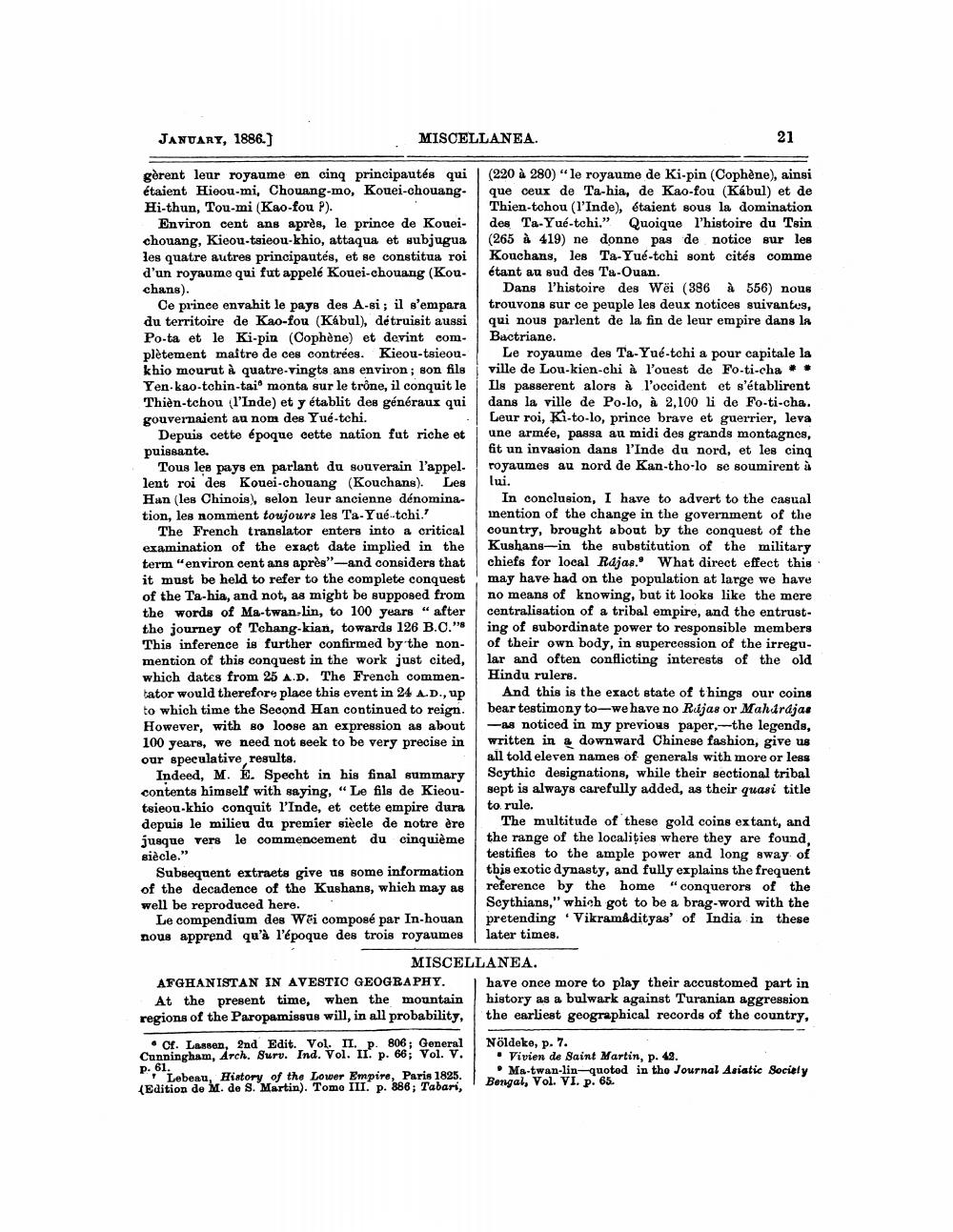________________
MISCELLANEA.
JANUARY, 1886.]
gèrent leur royaume en cinq principautés qui étaient Hieou-mi, Chouang-mo, Kouei-chouangHi-thun, Tou-mi (Kao-fou P).
Environ cent ans après, le prince de Koueichouang, Kieou-tsieou-khio, attaqua et subjugua les quatre autres principautés, et se constitua roi d'un royaume qui fut appelé Kouei-chouang (Kouchans).
Ce prince envahit le pays des A-si; il s'empara du territoire de Kao-fou (Kábul), détruisit aussi Po-ta et le Ki-pin (Cophène) et devint complètement maître de ces contrées. Kieou-tsieonkhio mourut à quatre-vingts ans environ; son fils Yen-kao-tchin-tai monta sur le trône, il conquit le Thien-tchou (l'Inde) et y établit des généraux qui gouvernaient au nom des Yué-tchi.
Depuis cette époque cette nation fut riche et puissante.
Tous les pays en parlant du souverain l'appellent roi des Kouei-chouang (Kouchans). Les Han (les Chinois), selon leur ancienne dénomination, les nomment toujours les Ta-Yué tchi."
The French translator enters into a critical examination of the exact date implied in the term "environ cent ans après"-and considers that it must be held to refer to the complete conquest of the Ta-hia, and not, as might be supposed from the words of Ma-twan-lin, to 100 years" after the journey of Tchang-kian, towards 126 B.C."8 This inference is further confirmed by the nonmention of this conquest in the work just cited, which dates from 25 A.D. The French commentator would therefore place this event in 24 A.D., up to which time the Second Han continued to reign. However, with so loose an expression as about 100 years, we need not seek to be very precise in our speculative results.
Indeed, M. E. Specht in his final summary contents himself with saying, "Le fils de Kieoutsieou-khio conquit l'Inde, et cette empire dura depuis le milieu du premier siècle de notre ère jusque vers le commencement du cinquième siècle."
Subsequent extraets give us some information of the decadence of the Kushans, which may as well be reproduced here.
Le compendium des Wei composé par In-houan nous apprend qu'à l'époque des trois royaumes
AFGHANISTAN IN AVESTIC GEOGRAPHY. At the present time, when the mountain regions of the Paropamissus will, in all probability,
Cf. Lassen, 2nd Edit. Vol. II. p. 806; General Cunningham, Arch. Surv. Ind. Vol. II. p. 66; Vol. V. p. 61. Lebeau, History of the Lower Empire, Paris 1825. (Edition de M. de S. Martin). Tome III. p. 886; Tabari,
(220 à 280) "le royaume de Ki-pin (Cophène), ainsi que ceux de Ta-hia, de Kao-fou (Kábul) et de Thien-tchou (l'Inde), étaient sous la domination des Ta-Yué-tchi." Quoique l'histoire du Tsin (265 à 419) ne donne pas de notice sur les Kouchans, les Ta-Yué-tchi sont cités comme étant au sud des Ta-Ouan.
Dans l'histoire des Wei (386 à 556) nous trouvons sur ce peuple les deux notices suivantes, qui nous parlent de la fin de leur empire dans la Bactriane.
21
Le royaume des Ta-Yué-tchi a pour capitale la ville de Lou-kien-chi à l'ouest de Fo-ti-cha Ils passerent alors à l'occident et s'établirent dans la ville de Po-lo, à 2,100 li de Fo-ti-cha. Leur roi, Ki-to-lo, prince brave et guerrier, leva une armée, passa au midi des grands montagnes, fit un invasion dans l'Inde du nord, et les cinq royaumes au nord de Kan-tho-lo se soumirent à lui.
In conclusion, I have to advert to the casual mention of the change in the government of the country, brought about by the conquest of the Kushans-in the substitution of the military chiefs for local Rajas. What direct effect this may have had on the population at large we have no means of knowing, but it looks like the mere centralisation of a tribal empire, and the entrusting of subordinate power to responsible members of their own body, in supercession of the irregular and often conflicting interests of the old
Hindu rulers.
MISCELLANEA.
And this is the exact state of things our coins bear testimony to-we have no Rujas or Maharajas -as noticed in my previous paper,-the legends, written in a downward Chinese fashion, give us all told eleven names of generals with more or less Scythic designations, while their sectional tribal sept is always carefully added, as their quasi title to rule.
The multitude of these gold coins extant, and the range of the localities where they are found, testifies to the ample power and long sway of this exotic dynasty, and fully explains the frequent reference by the home "conquerors of the Scythians," which got to be a brag-word with the pretending Vikramadityas' of India in these later times.
have once more to play their accustomed part in history as a bulwark against Turanian aggression the earliest geographical records of the country,
Nöldeke, p. 7.
Vivien de Saint Martin, p. 42.
Ma-twan-lin-quoted in the Journal Asiatic Society Bengal, Vol. VI. p. 65.




